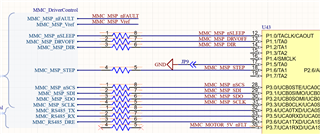Hello,
I am designing PCB board for Cubesat subsystem. It's MSP430FR based simple embedded system for stepper motor controll. My question may be a little trivial, but I am thinking about a tradeoff.
Is there strong reason to put small, series resistors (50 ohm) on every GPIO output and interface pin? I remember that that it may be useful to better control what is happening on the line, to prevent any spikes etc. In general, I know that resistor matched to the output impedance of the driver to result in 50 ohm total track impedance is needed to prevent any reflections, but is this really helpful for system signal integrity if real size of the PCB is rather small (10x10cm)?
Signals that I am driving:
- SPI, I2C, UART,
- Enable pin of the eFuse,
- mosfet gate (negation of eFuse enable input)
At the end of the day, I am adding additional component that may cause failure and increase total number of components.
Maybe for this size of the system it will be sufficient if I just keep 50 ohm impedance of the track?
Here is an example of my usecase:
Here I have 4x50 ohm resistor array.
I will be glad for any thoughts.
Best regards,
Slawomir
-
Ask a related question
What is a related question?A related question is a question created from another question. When the related question is created, it will be automatically linked to the original question.

